The pharmaceutical intermediates market is estimated to be valued at USD 47.30 Bn in 2025 and is expected to reach USD 82.70 Bn by 2032, growing at a compound annual growth rate (CAGR) of 8.3% from 2025 to 2032.
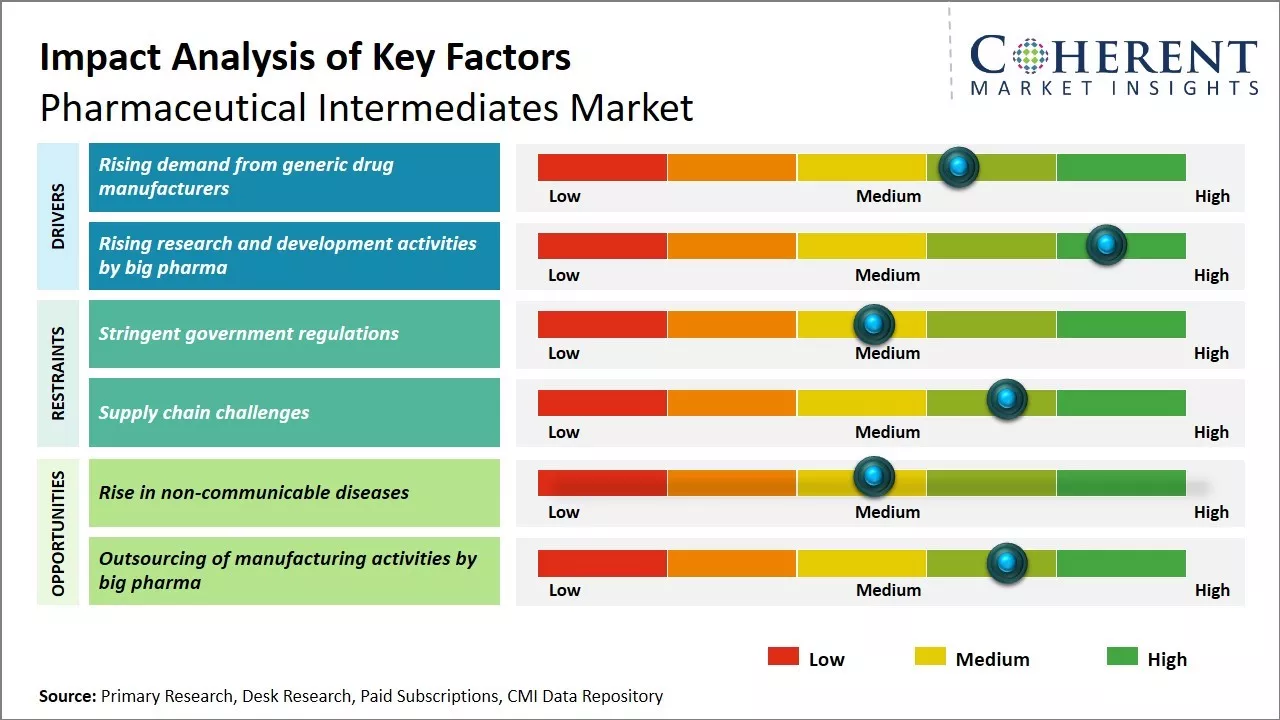
Discover market dynamics shaping the industry: Request sample copy
The pharmaceutical intermediates market is expected to witness significant growth over the forecast period. The demand for pharmaceutical intermediates is rising mainly owing to the increasing prevalence of diseases across the globe and growing need for medicines and drugs. The major factors driving the growth of this market include rising spending on healthcare worldwide coupled with the increasing consumption of generic drugs. Additionally, the growing production of active pharmaceutical ingredients (APIs) is also augmenting the demand for pharmaceutical intermediates. However, stringent regulations for the manufacturing and processing of pharmaceutical intermediates may hamper the growth of this market to some extent over the next few years.
Rising demand from generic drug manufacturers
The demand for pharmaceutical intermediates is being driven strongly by generic drug manufacturers. Over the past decade, the generic drug market has witnessed tremendous growth as many blockbuster drugs have lost their patent protection. This has paved the way for many generic versions of the original brand name drugs to be introduced in the market at much lower price points. Generics account for over 80% of the total prescriptions filled in major pharmaceutical markets today. However, the production of generic drugs requires large quantities of pharmaceutical intermediates which serve as the building blocks and raw materials. Most generic drug manufacturers do not have in-house capabilities to produce these intermediates and hence rely significantly on dedicated pharmaceutical intermediate producers.
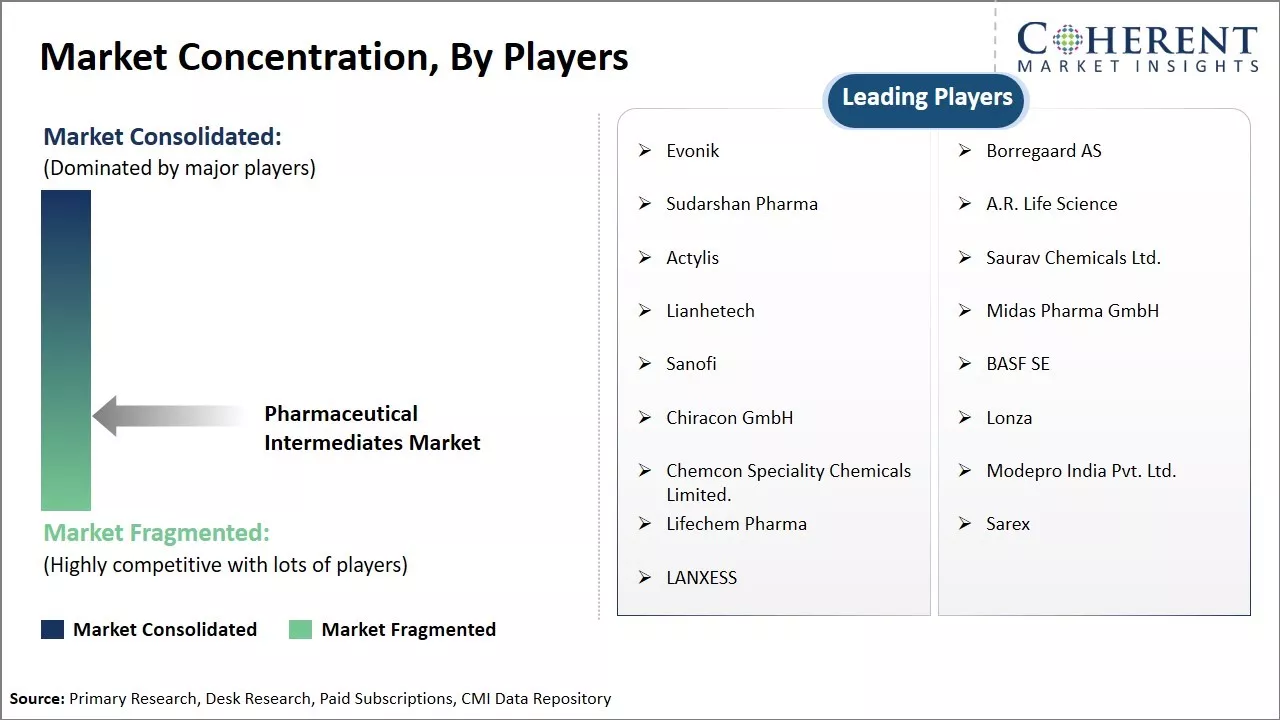
Get actionable strategies to beat competition: Request sample copy
Rising Research and Development Activities by Big PharmaAnother key driver for the pharmaceutical intermediates market has been the increasing research and development investments and activities undertaken by large pharmaceutical corporations. Despite facing numerous challenges, big pharma companies have continued devoting greater resources towards new drug development programs in therapeutically important areas. The discovery and development of new molecular entities requires the extensive synthesis, screening, and testing of various intermediates during the chemical process. Any candidate molecules demonstrating efficacy and safety are then subjected to further optimization and scale-up involving multifarious intermediates. The entire cycle from target identification to commercialization entails synthesizing multitudes of intermediates. Therefore, as big pharma’s R&D budgets and pipelines expand, they translate into higher outsourcing of intermediate manufacturing responsibilities.
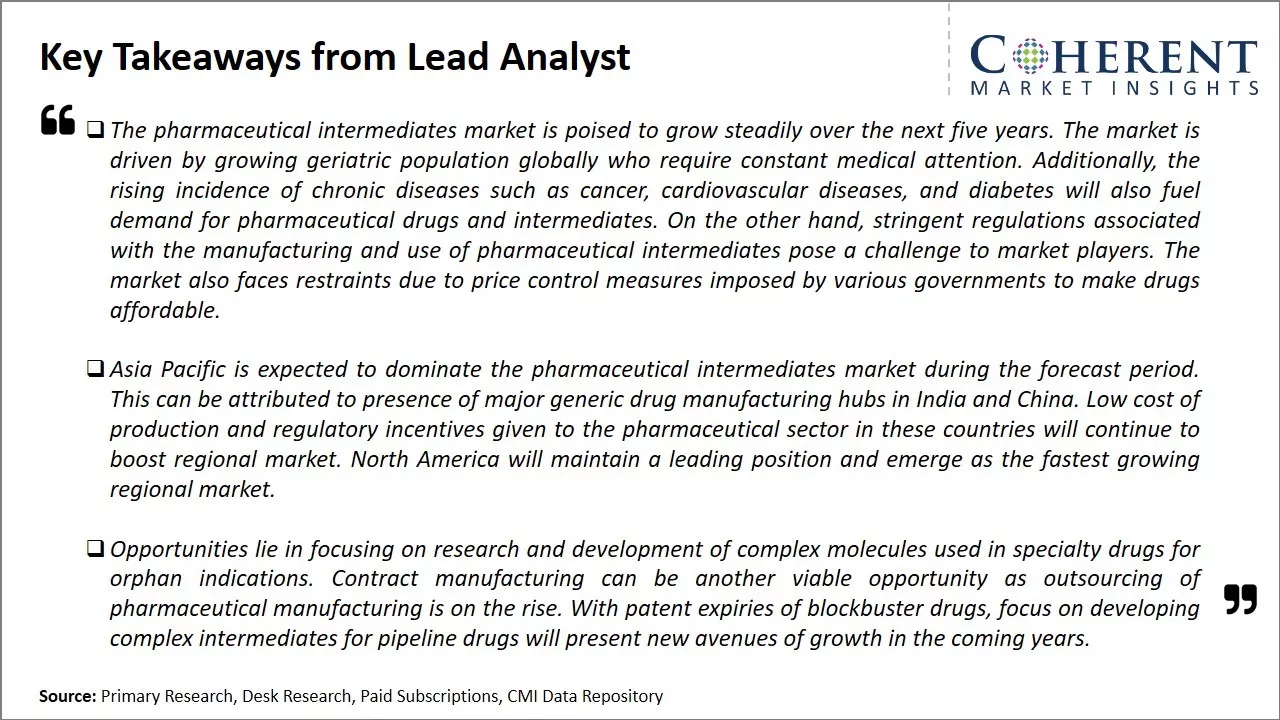
To learn more about this report, Request sample copy
Market Challenges – Stringent government regulations:The pharmaceutical intermediates market faces several challenges. Regulations are becoming more stringent globally which increases compliance costs. Additionally, price controls imposed by various countries impact profit margins. Developing innovative intermediates also requires huge investments in R&D. Securing reliable suppliers for key starting materials and facing intense competition from generics manufacturers further add to the challenges in this industry.
Market Opportunities – Rise in non-communicable diseases:
The pharmaceutical intermediates market also presents several opportunities for growth. As lifespans increase and non-communicable diseases rise, the demand for drugs will continue expanding worldwide. Outsourcing of intermediate production provides opportunity to capture a share of the global supplies. Emerging markets like India and China with their large populations offer vast potential for sales. Developing intermediates for niche therapy areas and orphan drugs can help gain higher margins.
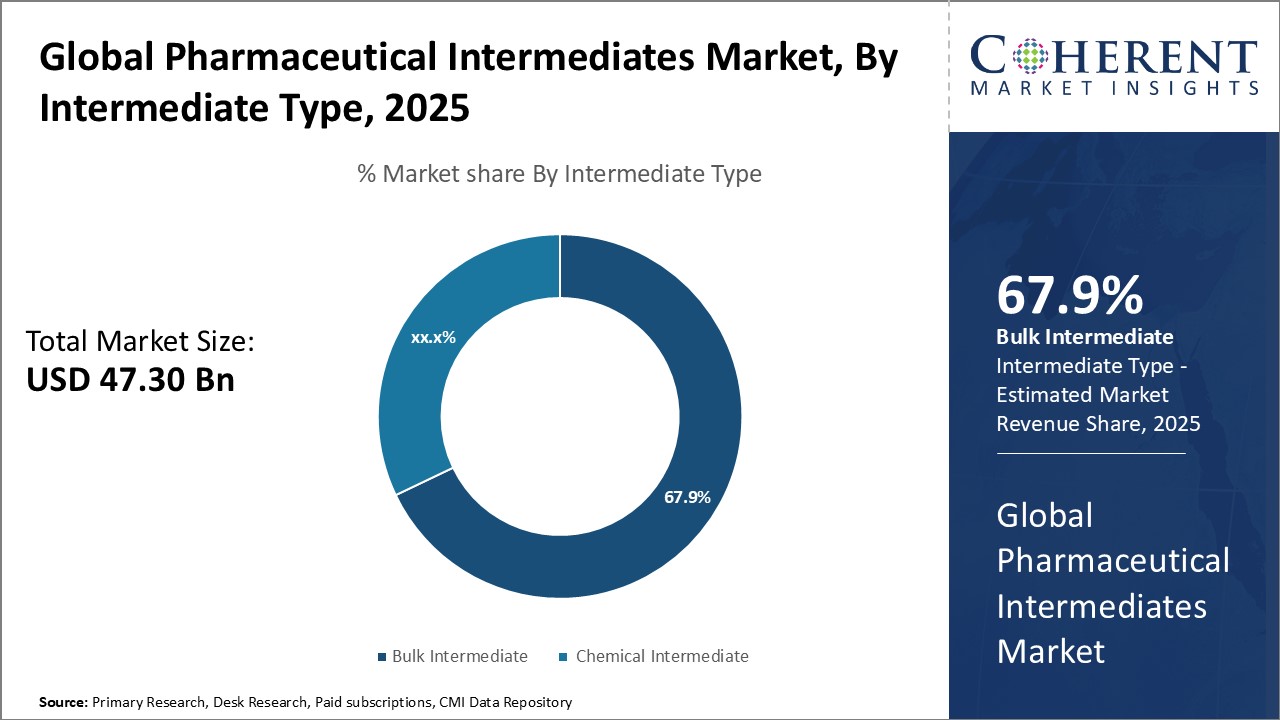
Discover high revenue pocket segments and roadmap to it: Request sample copy
Insights, By Intermediate Type: Massive Demand Drives the Bulk Intermediates SegmentThe intermediate type segment includes bulk intermediate and chemical Intermediate. The bulk intermediate segment is anticipated to have 67.9% of the total market share in 2025 owing to its widespread application across a variety of therapeutic areas. Bulk intermediates find use in the manufacture of numerous active pharmaceutical ingredients (APIs) that are utilized in drug formulation. Being basic building blocks, bulk intermediates experience substantial consumption from drug manufacturing companies. Their 'workhorse' status means that even minor adjustments to drug production can translate to sizeable demand changes for these intermediates.
Furthermore, innovative drug development relies on bulk intermediates to facilitate the synthesis of novel molecules during research activities. While resources are increasingly being diverted to biologics, traditional small-molecule drugs remain crucial for the treatment of many diseases. The constant search for next-generation chemicals and clinical candidates ensures the continued significance of bulk intermediates in the drug innovation pipeline.
Insights, By Application: Inflammatory Conditions Fuel Pain Management Needs
The application segment includes anti-infective drugs, analgesics, antidiabetic drugs, cardiovascular drugs, antimicrobial drugs, anti-inflammatory drugs, and others. Anti-inflammatory drugs are anticipated to account for 28.3% of the market share in 2025, owing to growing prevalence of arthritis. Arthritis is one of the most common causes of disability worldwide and affect about 528 million people globally, according to an article published by WHO in July 2023. As the geriatric population continues to rise globally, the incidence of arthritis is also increasing at an alarming rate. Osteoarthritis and rheumatoid arthritis are the most prevalent types of arthritis which seriously impact quality of life. Anti-inflammatory drugs are generally the first line of treatment for arthritis symptoms management and pain relief. Drugs such as ibuprofen, diclofenac and naproxen sodium are among the top selling anti-inflammatory medications due to their efficacy and affordability. Growing awareness about managing arthritis symptoms non-invasively through medications has propelled the demand for pharmaceutical intermediates used in anti-inflammatory drugs production.
Insights, By End User: Growing Number of CMO Companies Drives the Segment Growth
The end user segment includes biopharmaceutical Companies, CMO, CRO, and others. Within the pharmaceutical intermediates segment, CMOs is expected to account for 34% of share in 2025 owing to their extensive involvement across the drug production lifecycle. Contract Manufacturing Organizations (CMOs) allow innovative and generic pharmaceutical firms to outsource various aspects of drug substance and product development as well as manufacturing. This contract manufacturing activity is a major application area for pharmaceutical intermediates.
The expanding role of outsourcing encourages pharmaceutical companies to engage CMOs for a number of core and non-core operations, ranging from process R&D to route scouting, bulk manufacturing, and formulation. This outsourced approach streamlines in-house resources towards front-end drug innovation while leveraging the economies of scale offered by CMOs. Many innovators now focus on research activities and product commercialization, relying on CMOs to address production needs.
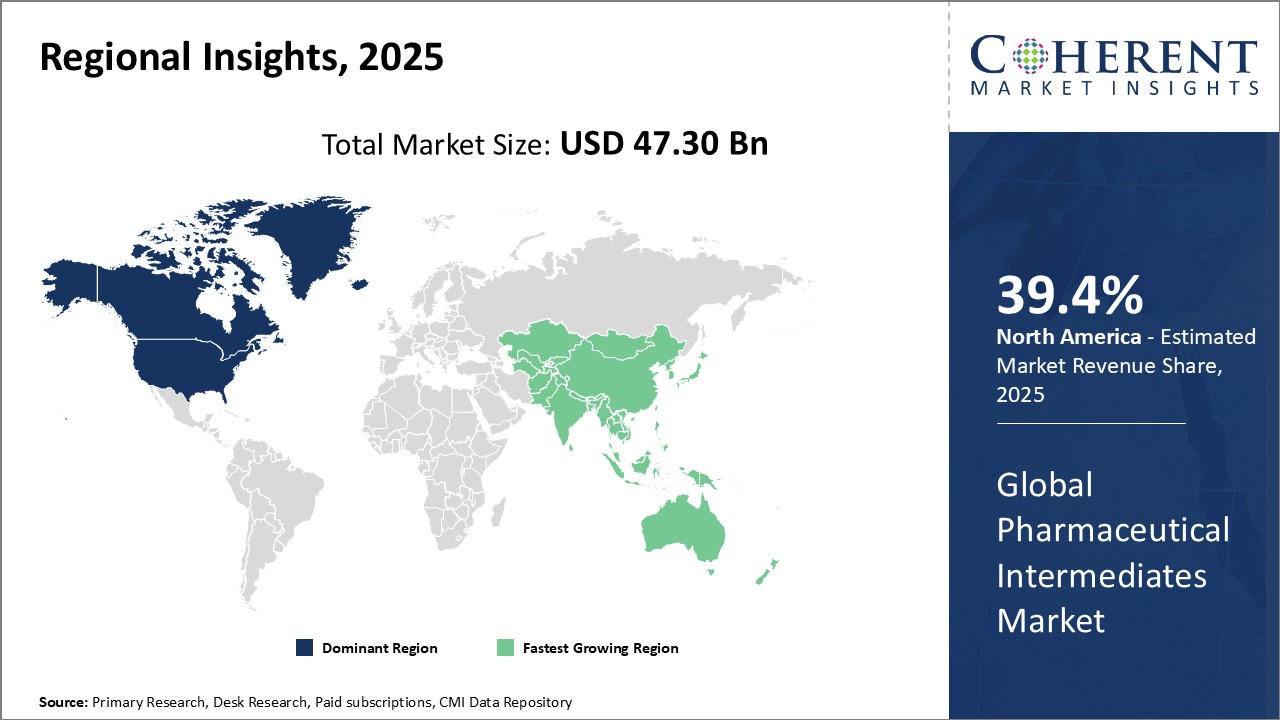
Need a Different Region or Segment? Customize now
North America has established itself as the dominant region in the global pharmaceutical intermediates market over the past few decades. North America is anticipated to have 39.4% of the market share in 2025. The presence of major pharmaceutical companies and an advanced healthcare infrastructure have contributed significantly to the growth of this industry in the region. Strong R&D capabilities along with continual innovations have enabled North American companies to introduce new drugs and medical technologies at a rapid pace. This, in turn, drives the demand for various pharmaceutical intermediates that are used extensively during the drug manufacturing process. Additionally, contract manufacturing has become a major business model for pharmaceutical companies in the region outsourcing the production of intermediates.
The Asia Pacific region is witnessing the fastest growth and is emerging as the new hotspot for pharmaceutical intermediates market. Rapid industrialization and investment in healthcare sectors across many Asia Pacific countries such as India, China, South Korea, and Australia have boosted the region's pharmaceutical output in recent years. Low manufacturing costs and availability of skilled labor are attracting major investments from pharmaceutical giants expanding outsourced manufacturing facilities in the region. India especially has transformed into a global hub for generic drug production leveraging its cost advantage along with a large talent pool of chemists and engineers. Chinese companies are also aggressively expanding by acquiring foreign intermediates manufacturers as well as investing heavily in R&D. With growing expertise in synthesis capabilities, APAC intermediates producers are increasingly catering to global markets from Japan to North America.
Global Pharmaceutical Intermediates Market Report Coverage
| Report Coverage | Details | ||
|---|---|---|---|
| Base Year: | 2024 | Market Size in 2025: | USD 47.30 Bn |
| Historical Data for: | 2020 To 2024 | Forecast Period: | 2025 To 2032 |
| Forecast Period 2025 to 2032 CAGR: | 8.3% | 2032 Value Projection: | USD 82.70 Bn |
| Geographies covered: |
|
||
| Segments covered: |
|
||
| Companies covered: |
Evonik, Borregaard AS, Sudarshan Pharma, A.R. Life Science, Actylis, Saurav Chemicals Ltd., Lianhetech, Midas Pharma GmbH, Sanofi , BASF SE, Chiracon GmbH, Lonza, Chemcon Speciality Chemicals Limited., Modepro India Pvt. Ltd., Lifechem Pharma, Sarex, LANXESS |
||
| Growth Drivers: |
|
||
| Restraints & Challenges: |
|
||
Uncover macros and micros vetted on 75+ parameters: Get instant access to report
*Definition: The pharmaceutical intermediates market refers to the business of manufacturing and selling chemicals or compounds that are used in the production of active pharmaceutical ingredients. These intermediates undergo further chemical reactions and processing to produce the final active drug components used in medicines. Companies in this market produce a wide range of organic intermediates that are supplied to pharmaceutical companies for manufacturing drugs and medications for various therapeutic applications.
Share
Share
About Author
Vipul Patil is a dynamic management consultant with 6 years of dedicated experience in the pharmaceutical industry. Known for his analytical acumen and strategic insight, Vipul has successfully partnered with pharmaceutical companies to enhance operational efficiency, cross broader expansion, and navigate the complexities of distribution in markets with high revenue potential.
Missing comfort of reading report in your local language? Find your preferred language :
Transform your Strategy with Exclusive Trending Reports :
Frequently Asked Questions
Joining thousands of companies around the world committed to making the Excellent Business Solutions.
View All Our Clients
US Reciprocal Tax Impact Analysis On Global Pharmaceutical Intermediates Market
Stay updated on tariff changes with expert insights and timely information